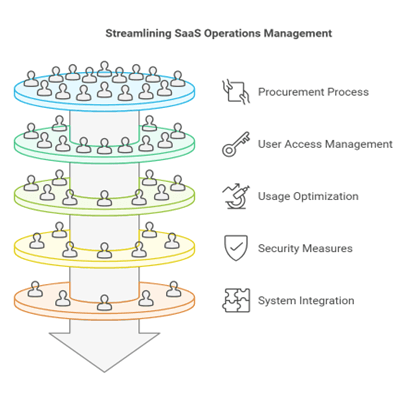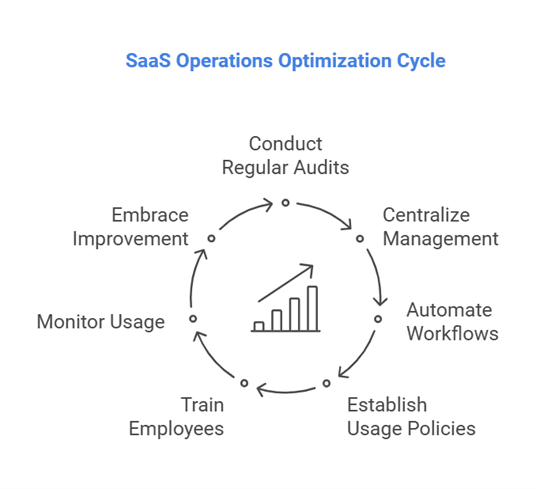SaaS Operations Management for Business Success
The way businesses operate is constantly changing, and one of the biggest changes in recent years is the shift towards Software as a Service (SaaS). SaaS applications are software programs that are hosted and accessed online, rather than being installed on individual computers. This has brought many advantages, like:
- Scalability: Companies can easily add or remove users as needed, making it easier to grow or shrink as business demands change.
- Cost-effectiveness: SaaS applications typically operate on a subscription basis, eliminating the need for expensive upfront investments and ongoing maintenance costs.
- Accessibility: SaaS applications can be accessed from anywhere with an internet connection, making it easier for teams to work remotely and collaborate effectively.
As a result of these benefits, SaaS applications are being adopted across industries and by companies of all sizes. While SaaS offers many benefits, it also presents unique challenges, particularly as the number of applications used by a business grows. This phenomenon, often referred to as SaaS sprawl, can lead to inefficiencies, security risks, and unexpected costs.
Managing multiple SaaS applications through traditional methods, like spreadsheets, is no longer sustainable. This is where SaaS Operations Management (SOM) becomes crucial. SOM involves a structured approach to managing the entire SaaS ecosystem within an organization, ensuring efficient and secure utilization of resources.
Effective SOM provides businesses with numerous benefits, including cost savings, enhanced security, improved productivity, and better alignment with overall business goals.
Understanding SaaS Operations Management: Key Concepts and Components
SOM encompasses various aspects of managing SaaS applications throughout their lifecycle within an organization. Let's take a closer look at the key components:
- Discovery: The first step is to identify all SaaS applications used within the organization. This includes applications officially approved by the IT department and those used by individual employees without formal approval, known as "shadow IT."
- Procurement: This involves streamlining the process of acquiring new SaaS applications. It includes evaluating business needs, researching available solutions, negotiating contracts with vendors, and ensuring that purchases align with budget constraints.
- Provisioning and Deprovisioning: SOM includes managing user access to SaaS applications. This involves granting new employees access to the tools they need for their roles (provisioning) and promptly revoking access when employees leave the company (deprovisioning).
- Usage Monitoring and Optimization: SOM requires tracking how SaaS applications are used within the organization. This data helps identify underutilized licenses, optimize spending, and ensure efficient resource allocation.
- Security and Compliance: Implementing robust security measures is critical in today's business environment. SOM includes setting up access controls, data encryption, and regular security updates to protect sensitive information and comply with relevant regulations.
- Integration: For SaaS applications to work effectively, they need to integrate seamlessly with existing systems and workflows within the organization. SOM involves ensuring that these integrations are properly configured and maintained.

The responsibility for managing these components typically falls on SaaS Operations teams. These teams often comprise individuals with expertise in IT, finance, security, and procurement, working together to ensure efficient and effective SaaS management.
Benefits of Effective SaaS Operations Management
Investing in robust SOM processes can bring significant benefits to organizations of all sizes. Here are some of the key advantages:
Cost Optimization:
- License Management: SOM helps organizations gain visibility into their SaaS licenses, identifying and eliminating unused or redundant subscriptions. This can significantly reduce software costs.
- Spend Visibility and Control: By centrally tracking SaaS expenses, organizations gain better control over their software budget. This prevents overspending and allows for more accurate budget forecasting.
- Negotiation Leverage: When negotiating contracts with SaaS vendors, insights into actual usage patterns provide organizations with leverage. This data helps justify pricing decisions and secure better deals.
Enhanced Security and Compliance:
- Centralized Security Management: SOM facilitates the implementation of consistent security policies across all SaaS applications. This ensures a unified approach to data protection and reduces the risk of breaches.
- Access Control and Data Protection: Through role-based access controls, organizations can restrict access to sensitive information based on job roles. This, coupled with data encryption measures, strengthens data protection and aids in compliance with regulations like GDPR and HIPAA.
- Compliance Monitoring and Auditing: Effective SOM practices involve regular monitoring and auditing of SaaS applications to ensure ongoing compliance with industry-specific regulations. This minimizes the risk of penalties and legal issues.
Increased Productivity and Efficiency:
- Workflow Automation: Automating repetitive tasks such as user provisioning and deprovisioning frees up valuable time for IT teams. Streamlined workflows lead to faster processes and reduced errors.
- Improved Collaboration: By integrating SaaS applications with existing communication and collaboration tools, SOM can enhance teamwork and information sharing across departments.
- Empowering Employees: When employees have access to the right tools and resources, they can work more efficiently and productively. This also leads to increased job satisfaction and reduced frustration.
Strategic Alignment and Business Growth:
- Data-Driven Decision Making: The insights gathered from centralized SaaS data can inform strategic business decisions. This data-driven approach can drive innovation and accelerate business growth.
- Agility and Adaptability: Efficient SaaS management enables organizations to be more agile and adaptable to changing market conditions. It allows them to quickly adopt new technologies and respond to emerging opportunities.
- Focus on Core Competencies: By reducing the burden of IT management, SOM allows organizations to focus on their core business objectives and strategic initiatives.
Challenges of Poor SaaS Operations Management
Failing to implement effective SOM practices can lead to several challenges that can negatively impact an organization's performance and security posture. Some of the key challenges include:
- Shadow IT: The use of unauthorized SaaS applications by employees without the knowledge or approval of the IT department creates security risks, compliance issues, and can lead to budget overruns.
- Cost Overruns: Uncontrolled SaaS spending, often resulting from a lack of visibility into licenses and subscriptions, can lead to unexpected expenses and exceeding budgetary allocations.
- Security Vulnerabilities: Inadequate security practices, such as weak passwords and outdated software versions, can expose sensitive data to breaches and cyberattacks. This can damage an organization's reputation and lead to financial losses.
- Compliance Risks: Failure to comply with data privacy regulations, such as GDPR or HIPAA, can result in hefty fines and legal repercussions.
- Operational Inefficiencies: Manual management of SaaS applications often leads to delays, errors, and frustrated employees. This can slow down business processes and impact productivity.
Best Practices for Optimizing SaaS Operations
To effectively manage and optimize SaaS operations, organizations should consider implementing these best practices:

- Conduct Regular SaaS Audits: Regular audits help identify and address potential issues before they escalate. These audits should aim to uncover unused licenses, shadow IT instances, and security vulnerabilities.
- Implement a Centralized SaaS Management Platform: Dedicated SaaS management solutions provide organizations with a centralized view of their SaaS ecosystem. This allows them to track usage, manage licenses, enforce security policies, and streamline workflows.
- Automate Workflows: Automation can significantly improve efficiency and reduce errors in SaaS operations. Key workflows like user provisioning and deprovisioning, license renewals, and security updates can be automated.
- Establish Clear SaaS Usage Policies: Organizations should establish clear policies regarding software requests, approvals, security protocols, and usage guidelines. These policies should be communicated clearly to all employees.
- Prioritize Employee Training and Onboarding: Proper training and support are essential to ensure employees understand how to effectively use SaaS applications. This maximizes the return on investment and minimizes security risks.
- Monitor Usage and Optimize Spending: Organizations should regularly monitor SaaS usage and spending patterns. This helps identify cost-saving opportunities, prevent overruns, and ensure resources are allocated efficiently.
- Embrace Continuous Improvement: SOM is not a one-time project but an ongoing process. Organizations should continuously evaluate and refine their SaaS operations processes to adapt to changing needs and improve efficiency.
The Future of SaaS Operations Management
The field of SOM is constantly evolving, driven by advancements in technology and the increasing reliance on SaaS applications.
- Artificial Intelligence and Machine Learning: AI and ML are playing an increasingly important role in SOM. These technologies can automate tasks, predict usage patterns, identify security threats, and provide proactive insights for optimization.
- Integration with Emerging Technologies: The integration of SOM with emerging technologies like blockchain, IoT, and edge computing presents new opportunities for enhanced security, automation, and data management. However, the implications of these integrations are still being explored.
- The Evolving Role of SaaS Operations Professionals: As SOM becomes more complex and technology-driven, the skills and expertise required for SOM roles are also evolving. Professionals in this field need to stay abreast of emerging technologies and develop skills in areas like automation, data analytics, and cybersecurity.
##How AlphaSaaS Transforms SaaS Operations from Chaos to Clarity?
SaaS Operations Management is no longer a nice-to-have, it's a business imperative. And this is exactly where AlphaSaaS steps in.
AlphaSaaS helps organizations discover every SaaS and shadow IT app, analyze usage across teams, and eliminate wasteful spending, without relying solely on API integrations. Its unique Usage Analytics with Health-Card feature gives finance and IT leaders instant clarity on which apps are critical, which are idle, and where the real savings lie. By combining deep visibility with intelligent insights, AlphaSaaS empowers businesses to take action, faster, smarter, and with confidence.
Whether you're just starting to get a handle on your SaaS sprawl or scaling SaaS governance across departments, AlphaSaaS acts as your co-pilot for SaaS operations, making sure every app earns its place.
Conclusion: Embracing SaaS Operations Management for Business Success
In today's digital landscape, effective SOM is no longer a luxury but a necessity for organizations of all sizes. By adopting a strategic approach to SOM and implementing best practices, businesses can reap numerous benefits, including:
- Significant cost savings through optimized license management and spending control
- Enhanced security and reduced risk of data breaches and compliance violations
- Improved productivity and efficiency through workflow automation and seamless integration
- Better alignment of IT resources with strategic business goals
By proactively managing their SaaS ecosystems, organizations can unlock the full potential of these powerful tools and pave the way for sustainable growth and success.
Empower your team with the right SaaS tools and workflows. AlphaSaaS helps you improve team collaboration, streamline onboarding, and boost productivity. Get started with us to simplify your SaaS management and unlock your company's full potential!

Aisha Javed
Aisha, a thinker, a reader, a doodler and quite an observer. She enjoys meaningful conversations and believes that food is the ultimate source of happiness. She is passionate about learning new things and is drawn to picking up new hobbies, although she isn’t very good at sticking to them.